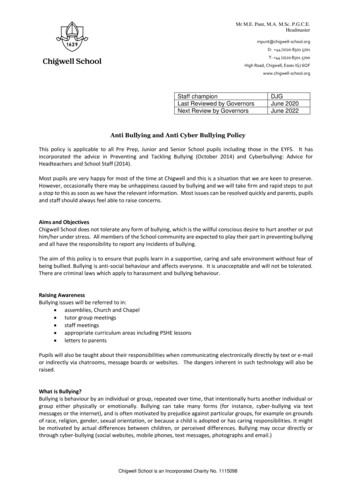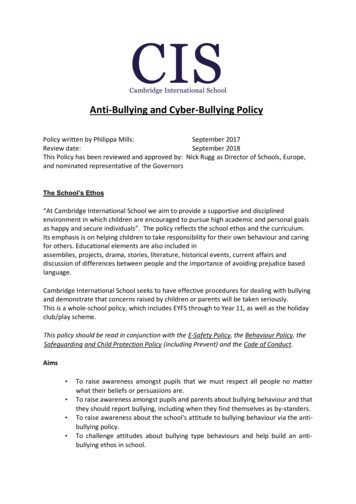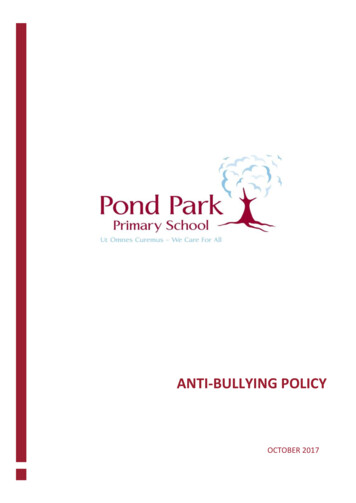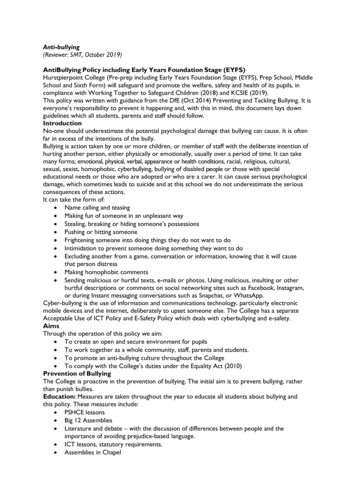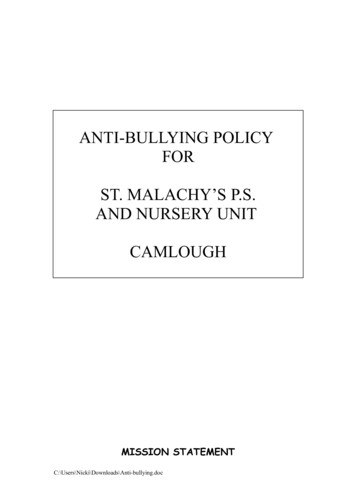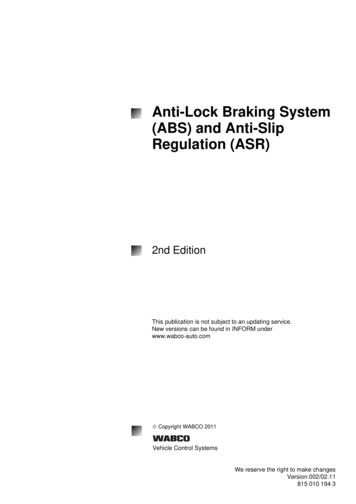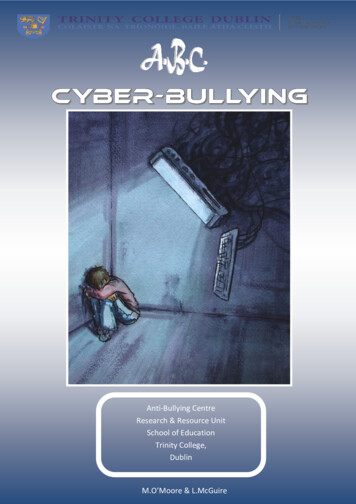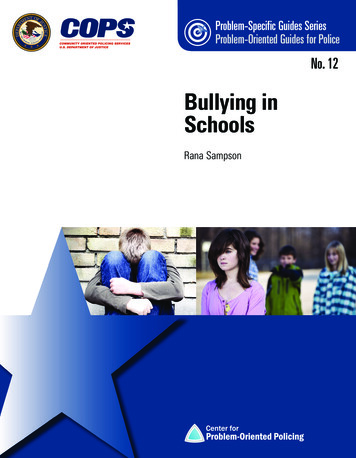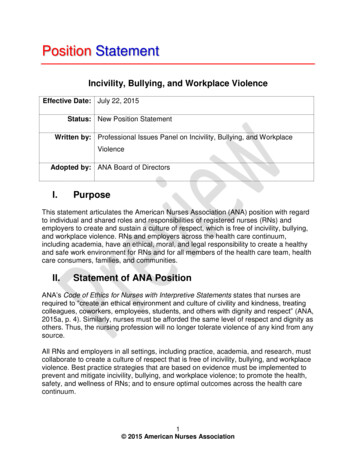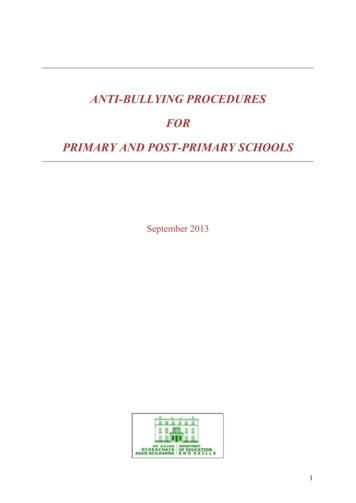
Transcription
ANTI-BULLYING PROCEDURESFORPRIMARY AND POST-PRIMARY SCHOOLSSeptember 20131
Table of Contents1. INTRODUCTION AND LEGAL FRAMEWORK . 31.1 INTRODUCTION . 31.2 REQUIREMENT ON ALL SCHOOLS TO HAVE AN ANTI-BULLYING POLICY WITHIN THE FRAMEWORK OF THEIR OVERALLCODE OF BEHAVIOUR . 31.3 ANTI-BULLYING PROCEDURES FOR PRIMARY AND POST-PRIMARY SCHOOLS . 41.4 SUMMARY OF MAIN ELEMENTS. 52. DEFINITION AND TYPES OF BULLYING . 82.1 DEFINITION OF BULLYING. 82.2 TYPES OF BULLYING . 93. IMPACT AND INDICATORS OF BULLYING BEHAVIOUR . 113.1 IMPACTS OF BULLYING BEHAVIOUR . 113.2 INDICATORS OF BULLYING BEHAVIOUR . 114. CHARACTERISTICS ASSOCIATED WITH BULLYING . 134.1 THE PUPIL WHO ENGAGES IN BULLYING BEHAVIOUR . 134.2 THE PUPIL WHO IS BULLIED . 134.3 MORE VULNERABLE PUPILS . 144.4 WHERE DOES BULLYING HAPPEN?. 155 A SCHOOL’S ANTI-BULLYING POLICY . 175.1 REQUIREMENT TO HAVE AN ANTI-BULLYING POLICY AND TO USE THE POLICY TEMPLATE. 175.2 DEVELOPMENT OF THE POLICY . 175.3 COMMITMENT TO KEY PRINCIPLES OF BEST PRACTICE. 185.4 COMMUNICATION OF THE POLICY . 195.5 PREVENTION OF HARASSMENT. 196 KEY PRINCIPLES OF BEST PRACTICE . 216.1 POSITIVE SCHOOL CULTURE AND CLIMATE . 216.2 EFFECTIVE LEADERSHIP . 236.3 A SCHOOL-WIDE APPROACH . 246.4 SHARED UNDERSTANDING OF WHAT BULLYING IS AND ITS IMPACT . 256.5 IMPLEMENTATION OF EDUCATION AND PREVENTION STRATEGIES INCLUDING AWARENESS RAISING . 256.6 EFFECTIVE SUPERVISION AND MONITORING OF PUPILS . 276.7 SUPPORTS FOR STAFF. 286.8 CONSISTENT INVESTIGATION, FOLLOW UP AND RECORDING OF BULLYING BEHAVIOUR (INCLUDING USE OFESTABLISHED INTERVENTION STRATEGIES) . 286.9 ONGOING EVALUATION OF THE EFFECTIVENESS OF THE ANTI- BULLYING POLICY . 357. OVERSIGHT . 367.1 PERIODIC SUMMARY REPORTS TO THE BOARD OF MANAGEMENT . 367.2 ANNUAL REVIEW BY THE BOARD OF MANAGEMENT . 367.3 DEPARTMENT INSPECTORATE . 37APPENDIX 1 TEMPLATE ANTI-BULLYING POLICY . 38APPENDIX 2 PRACTICAL TIPS FOR BUILDING A POSITIVE SCHOOL CULTURE AND CLIMATE . 42APPENDIX 3 TEMPLATE FOR RECORDING BULLYING BEHAVIOUR . 43APPENDIX 4 CHECKLIST FOR ANNUAL REVIEW OF THE ANTI-BULLYING POLICY AND ITSIMPLEMENTATION . 44NOTIFICATION REGARDING THE BOARD OF MANAGEMENT’S ANNUAL REVIEW OF THE ANTIBULLYING POLICY. 452
1. INTRODUCTION AND LEGAL FRAMEWORK1.1 Introduction1.1.1The role of the school is to provide an appropriate education for all its pupils. Astable, secure learning environment is an essential requirement to achieve this goal.Bullying behaviour, by its very nature, undermines and dilutes the quality of education.Research shows that bullying can have short and long-term effects on the physical andmental well-being of pupils, on engagement with school, on self-confidence and on theability to pursue ambitions and interests.1.1.2School-based bullying can be positively and firmly addressed through a rangeof school-based measures and strategies through which all members of the schoolcommunity are enabled to act effectively in dealing with this behaviour. While it isrecognised that home and societal factors play a substantial role both in the cause and inthe prevention of bullying, the role of the school in preventative work is also crucial andshould not be underestimated. School-based initiatives can either reinforce positive effortsor help counteract unsuccessful attempts of parents to change unacceptable behaviour.Parents and pupils have a particularly important role and responsibility in helping theschool to prevent and address school-based bullying behaviour and to deal with anynegative impact within school of bullying behaviour that occurs elsewhere.In thisdocument, any reference(s) to parent(s) can be taken to refer also to guardian(s) whereapplicable.1.1.3International research clearly indicates the crucial importance of the existenceof and implementation of a school policy setting out the school’s approach to preventingand tackling bullying. An anti-bullying policy, when developed and implemented acrossthe school community can be the cornerstone in countering bullying behaviour in schools.1.2 Requirement on all schools to have an anti-bullying policy within the frameworkof their overall code of behaviour1.2.1Under the Education (Welfare) Act, 2000 all schools are required to have inplace a code of behaviour. The Act requires that this code must be prepared in accordancewith guidelines issued by the National Educational Welfare Board (NEWB). The NEWB’s3
publication Developing a Code of Behaviour: Guidelines for Schools was issued to schoolsin 2008.1.2.2In accordance with the Education (Welfare) Act, 2000 and the guidelines issuedby the NEWB, all schools are required to have an anti-bullying policy within the frameworkof their overall code of behaviour.1.3 Anti-Bullying Procedures for Primary and Post-Primary Schools1.3.1These Anti-Bullying Procedures for Primary and Post-Primary Schools(hereinafter referred to as “these procedures”) have been developed following consultationwith the relevant education partners and replace the 1993 Guidelines on CounteringBullying Behaviour in Primary and Post-Primary Schools. These procedures have resultedfrom a review of the 1993 guidelines and the implementation of the Action Plan on Bullying– Report of the Anti-Bullying Working Group to the Minister for Education and Skills whichwas published in January 2013.1.3.2The purpose of these procedures is to give direction and guidance to schoolauthorities and school personnel in preventing and tackling school-based bullyingbehaviour amongst its pupils and in dealing with any negative impact within school ofbullying behaviour that occurs elsewhere. These procedures apply to all recognisedprimary and post-primary schools and to centres for education (as defined in the EducationAct 1998) which are attended by pupils under the age of 18 years. Where a school catersfor vulnerable adults these procedures also apply to those adult learners. School authoritiesand school personnel are required to adhere to these procedures in dealing with allegationsand incidents of bullying.1.3.3All Boards of Management must formally adopt and implement an anti-bullyingpolicy that fully complies with the requirements of these procedures. The school’s antibullying policy must be made available to school personnel, published on the schoolwebsite (or where none exists, be otherwise readily accessible to parents and pupils onrequest) and provided to the Parents’ Association (where one exists). A copy of theschool’s anti-bullying policy must be provided to the Department of Education and Skills(hereinafter referred to as “the Department”) and the patron if requested.4
1.4 Summary of Main Elements1.4.1The following is a summary of the main elements of these procedures: All Boards of Management are required to formally adopt andimplement an anti-bullying policy that fully complies with therequirements of these procedures. A template anti-bullying policy whichmust be used by all schools for this purpose is provided in Appendix 1of these procedures. The school’s anti-bullying policy must be made available to schoolpersonnel, published on the school website (or where none exists, beotherwise readily accessible to parents and pupils on request) andprovided to the Parents’ Association (where one exists). A copy of theschool’s anti-bullying policy must be provided to the Department andthe patron if requested. Bullying is defined as unwanted negative behaviour, verbal,psychological or physical, conducted by an individual or group againstanother person (or persons) and which is repeated over time. Theseprocedures make clear that this definition includes cyber-bullying andidentity-based bullying (such as homophobic bullying and racistbullying). These procedures outline key principles of best practice for bothpreventing and tackling bullying and require all schools to commit tothese principles in their anti-bullying policy. The key principles are:o A positive school culture and climate;o Effective leadership;o A school-wide approach;o A shared understanding of what bullying is and its impact;o Implementation of education and prevention strategies (includingawareness raising measures);o Effective supervision and monitoring of pupils;o Supports for staff;o Consistent recording, investigation and follow up of bullyingbehaviour (including use of established intervention strategies);5
o On-going evaluation of the effectiveness of the anti-bullyingpolicy. These procedures recognise that a cornerstone in the prevention ofbullying is a positive school culture and climate that is welcoming ofdifference and diversity and is based on inclusivity and respect. Theseprocedures outline key elements of a positive school culture and climateand also provide schools with some practical tips for building a positiveschool culture and climate. These procedures highlight the importance of a school-wide(management, staff, pupils and parents) approach.In addition to therole of management and staff, parents and pupils have a role andresponsibility in helping the school to prevent and address school-basedbullying behaviour and to deal with any negative impact within schoolof bullying behaviour that occurs elsewhere. These procedures require that the prevention of bullying must be anintegral part of a school’s anti-bullying policy. The education andprevention strategies that the school will implement must be documentedin the anti-bullying policy and must explicitly deal with the issue ofcyber-bullying and identity-based bullying including in particular,homophobic and transphobic bullying. A school’s anti-bullying policy must also set out the school’s proceduresfor investigating and dealing with bullying and the school’s proceduresfor the formal noting and recording of bullying behaviour. The school’sprocedures must be consistent with the guidance and direction set out inthis document. These procedures emphasise that the primary aim in investigating anddealing with bullying is to resolve any issues and restore as far as ispracticable the relationships of the parties involved (rather than toapportion blame).6
In any case where it has been determined by the relevant teacher thatbullying behaviour has occurredo the parents of the parties involved should be contacted at an earlystage to inform them of the matter and explain the actions beingtaken (by reference to the school policy); ando the relevant teacher must keep appropriate written records whichwill assist his/her efforts to resolve the issues and restore, as faras is practicable, the relationships of the parties involved. The relevant teacher must record the bullying behaviour in thestandardised recording template at Appendix 3 (and a copy must beprovided to the Principal or Deputy Principal as applicable) in thefollowing circumstances:o in cases where he/she considers that the bullying behaviour hasnot been adequately and appropriately addressed within 20school days after he/she has determined that bullying behaviouroccurred; ando where the school has decided as part of its anti-bullying policythat in certain circumstances bullying behaviour must berecorded and reported immediately to the Principal or DeputyPrincipal as applicable. The procedures include oversight arrangements which require that, atleast once in every school term, the Principal will provide a report to theBoard of Management setting out:o the overall number of bullying cases reported (by means of thebullying recording template in Appendix 3) to the Principal orDeputy Principal since the previous report to the Board ando confirmation that all of these cases have been, or are being, dealtwith in accordance with the school’s anti-bullying policy andthese procedures.7
As part of the oversight arrangements, the Board of Management mustundertake an annual review of the school’s anti-bullying policy and itsimplementation by the school. Written notification that the review hasbeen completed must be made available to school personnel, publishedon the school website (or where none exists, be otherwise readilyaccessible to parents and pupils on request) and provided to the Parents’Association (where one exists). A standardised notification which mustbe used for this purpose is included at Appendix 4. A record of thereview and its outcome must be made available, if requested, to thepatron and the Department.1.4.2The above is a summary of the main elements of these procedures and shouldtherefore be read within the overall context of this document.2. DEFINITION AND TYPES OF BULLYING2.1 Definition of bullying2.1.1In the context of these procedures, bullying is defined as unwanted negativebehaviour, verbal, psychological or physical conducted by an individual or group againstanother person (or persons) and which is repeated over time.2.1.2The following types of bullying behaviour are included in this non-exhaustivedefinition:(i)deliberate exclusion, malicious gossip and other forms of relationalbullying;(ii)cyber-bullying; and(iii) identity-based bullying such as homophobic bullying, racist bullying,bullying based on a person’s membership of the Traveller community andbullying of those with disabilities or special educational needs.2.1.3In addition, in the context of these procedures placing a once-off offensive orhurtful public message, image or statement on a social network site or other public forumwhere that message, image or statement can be viewed and/or repeated by other people willbe regarded as bullying behaviour.8
2.1.4Isolated or once-off incidents of intentional negative behaviour including aonce-off offensive or hurtful text message or other private messaging do not fall within thisdefinition of bullying and should be dealt with, as appropriate, in accordance with theschool’s code of behaviour. A single incident can have a serious effect on a pupil and mayalso constitute harassment which is legally prohibited in schools under equality legislation.Harassment is any form of unwanted conduct related to any of the nine discriminatorygrounds (gender including transgender, civil status, family status, sexual orientation,religion, age, disability, race and membership of the Traveller community).Information on the impact, indicators and other characteristics of bullying behaviour is setout in Sections 3 and 4 of these Procedures.2.2 Types of bullyingThe following are some of the types of bullying behaviour that can occur amongst pupils:o Physical aggression: This behaviour includes pushing, shoving, punching, kicking,poking and tripping people. It may also take the form of severe physical assault. Whilepupils often engage in ‘mess fights’, they can sometimes be used as a disguise forphysical harassment or inflicting pain.o Intimidation: Some bullying behaviour takes the form of intimidation: it may bebased on the use of very aggressive body language with the voice being used as aweapon. Particularly upsetting can be a facial expression which conveys aggressionand/or dislike.o Isolation/exclusion and other relational bullying: This occurs where a certainperson is deliberately isolated, excluded or ignored by some or all of the class group.This practice is usually initiated by the person engaged in bullying behaviour and canbe difficult to detect. It may be accompanied by writing insulting remarks about thepupil in public places, by passing around notes about or drawings of the pupil or bywhispering insults about them loud enough to be heard. Relational
Act 1998) which are attended by pupils under the age of 18 years. Where a school caters for vulnerable adults these procedures also apply to those adult learners. School authorities and school personnel are required to adhere to these procedur
